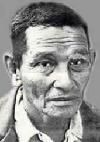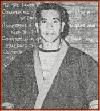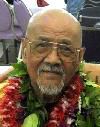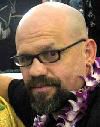The Pit Malibu's Hawaiian Kempo Karate Lineage Is As Follows:
James Mitose
(Chinese Kempo) -->
William Chow
(Kempo) -->
Adriano Emperado
(KaJuKenBo Founder & Eskrima) -->
Walter Godin
(Kempo) -->
John Hackleman
(THE PIT Founder-Hawaiian Kempo) -->
Rick Metzler
(THE PIT MALIBU Founder-Hawaiian Kempo & Cacoy Doce Pares-Eskrima & Eskrido)
The Beginning
Hawaiian Kempo is a unique martial art having been founded several centuries ago in a Chinese Shaolin temple. Thus, bringing with it a certain air of mystery. As a martial art, Kempo is referred to as a Do. The Do is referred to in Buddhist Zen scripts as a path towards enlightenment. Lao Tzu, a priest of Taoism, said "Mastering others requires force, mastering the self requires enlightenment." This phrase sums the full circle of what Kempo strives towards. Although on its surface Kempo can be seen as a unique form of self-defense, hidden beneath its physical exterior are levels where characteristic centralization of mind and body form. At this level, Kempo's practitioners elevate from a simple form of fighting to a higher level of ability and enlightenment. Ying Kuchan, a Shaolin monk and master of Kempo, after a lengthy period of meditation in a Zen rock garden, spoke of Kempo saying "Kempo is the power of adaptability and yielding, the harmony of all things working together."
Kempo is a unique art form of spiritual growth, health, and personal responsibility. It is a comprehensive and diversified means of unarmed self-defense, though it encompasses both an armed and unarmed systems of combat with techniques (applications) of varying appearances and methods.
On an external level, Kempo is a no holds barred fighting system of offensive and defensive methods, with equal emphasis of striking techniques with the hands and feet, immobilization and controls, projections and take downs; as well as weaponry, various spiritual, and healing arts.
Kempo, as developed in America, is a street wise defensive art that does not restrict its students in methodology. Clawing hands evolve into slashing feet. Cunning joint locks turn into devastating hip throws. Evasive blocks turn into breath closing chokes. The possibilities are endless. The only true fighting systems are those where there are no rules applied. From the books of the Han dynasty, we learn "Nothing is impossible to a willing mind." And it is from this saying that we can derive the upper principles of Shaolin Kempo. What sets Kempo apart from boxing, wrestling, and Sunday night football is an emphasis on spirituality of body and mind.
Many people are quite happy with only the surface value of Kempo, taking its studies for reasons of physical health, self-defense, or a Monday night hobby. Yet, Kempo tries to build a person's psychological persona and betterment. Kempo is not solely a means of felling an opponent by force, but it teaches an inner peace to one's life and to the universe around us.
Daruma Buddha
Kempo originated in China by Daruma Buddha in 525 ad. Daruma was originally from India, but moved to China to teach Buddhism. He originated Kempo to teach a method of self-defense to the villagers, who were being robbed and brutalized by Canton warlords and bandits. He felt fighting was wrong, but he felt not being prepared was worse. He fasted and meditated for many days until he came up with a fighting system. He called it Go Shin Jutsu Kenpo Karate, which means The self-defense art of the open hand. His new fighting system turned the villagers' bodies into weapons....hands, feet, elbows, knees, even heads.
40 years or so after the death of Daruma, sieges on the temple continued and a single man from the
Temple, known as the "begging monk" fought off several of the outlaws with an array of aggressive
hand & foot techniques driving the remaining attackers away. The other monks were so inspired by the
display of this single priest that they requested tutelage in this martial style as a means of protection.
In later scripts, the kanji for this fighting art was recorded & pronounced as “Kempo” meaning “Fist Method” or "Law Of The Fist".
James Mitose
In 1920, at the age of 3, a young boy named James Mitose was sent to Japan to be given a formal education and upbringing. While there, in addition to his normal schoolwork and university studies, he trained in the art of Kempo. Kempo had been brought over to Okinawa from China and had grown with great popularity. After training in Kempo for 17 years, he returned to the United States on February 25th, 1937, arriving in Honolulu Hawaii on the SS Tatsuta Maru at the age of 20. There he continued to train and in 1942 he set up a martial arts school. He gave the style he taught a number of different names during his lifetime including “Shorinji Kempo” & “Kempo Jujutsu”.
William Chow
William Kwai Sun Chow was born July 3, 1914, the third child and first son to Sun Chow Hoon, also known as Ah Hoon Chow and rose Kalamalio Naehu.
After his mother’s death in 1925, Professor Chow dropped out of school at the age of 11, having completed only the 6th grade. William Chow learned to live on his own while drifting from one friend and relative to another. One of his more influential friends was that of James Mitose. With that friendship and time on his hands, Professor Chow trained and refined the techniques learned & taught by Mitose. Chow was a firm believer in the martial arts and more specifically, Kempo, have a sole purpose of combat and warfare with less emphesis on spiritual enlightenment.
Adriano Emperado (Founder of KaJuKenBo)
The name KaJuKenBo pays respect to the five arts that went into it's creation.
-
KA = Karate
JU = Judo and Jiu-Jitsu
-
KEN = Hawaiian Ken/mpo
-
BO = Chinese & Western Boxing
With this appreciation and blend of these complimenting sytles, it's understandable to hear Kajukenbo referred to as the truly original American Mixed Martial Art.
Sijo Adriano Emperado is the man credited with putting Kajukenbo together from the roots created by the Black Belt Society.
Adriano Emperado, the founder of the Kajukenbo Self-Defense Institute of Hawaii, was born in Honolulu on June 16th, 1926 in the small community of Kalihi, which was and still is a part of the Kalihi-Palama District of the City and County of Honolulu. Adriano was one of seven children. There were three boys (Larry, Adriano, and Joseph), and four girls (Ella, Dechi, Nancy, and Connie Marcella). Like a lot of poor neighborhoods around the world, Kalihi and the surrounding area was a violent place to live. Because of this, Adriano started learning how to defend himself at a very young age. His father had been a professional boxer in the Philippines and in Hawaii, fighting under the ring name of Bulldog Panis. Adriano's uncle had also been a professional boxer. So by the time he was 8 years old he was getting some much needed exposure to western boxing.
Professor Emperado received much of his martial arts training from Professor K.S. Chow and Professor James Mitose.
Between the years of 1947–1952, he was part of the Black Belt Society that developed the art form currently known as KaJuKenBo. During these years Emperado together with 4 other masters of their respective arts developed KaJuKenBo to complement each others styles, to allow effective fighting at all ranges and speeds. It was decided that Kem(n)po would be the scaffolding, around, which KaJuKenBo was built. To test the effectiveness of their original techniques the five founders would get into fights around Palama settlement (the worst slum in Hawaii, at the time). If the technique succeeded consistently in street fighting, it was kept as part of the system. From these field test came Kajukenbo.
Professor Emperado is a master of Eskrima, Jujitsu, and various Kenpo forms. In addition, he has studied Okinawan Karate, Chinese Kung Fu, Hawaiian Lua, American Boxing and Wrestling, as well as various arts which utilize such weapons as the staff, club and knife. During World War II, Professor Emperado was attached to the First Filipino Infantry Regiment as a Medical Corp Man, during which time he received various awards and citations for military accomplishments. The arts drawn upon to found KaJuKenBo are Karate(Shotokan practiced by a Korean and mistakenly referred to as Tang Soo Do for this reason), Judo, Ju-jitsu, Kempo, and Chu'an Fa(Chinese boxing); hence the name Ka-ju-ken-bo
The five men that created this art were,
-
Walter Choo (who was Korean but unlike many believe, did not practice the Korean art of Tang Soo Do but rather Japanese ShotokanKarate)
-
Joe Holck ( Danzan Ryu Judo and Ju Jitsu)
-
Frank Ordonez ( Danzan Ryu Ju Jitsu)
-
Adriano Emperado (Kosho Ryu Kem(n)po)
-
Clarence Chang (Sil Lum Gung Fu or Chinese Boxing).
In 1952 KaJuKenBo became a popular & feared art. In Hawaii it evolved into a very powerful and violent fighting style. Kempo/KaJuKenBo fighters had the reputation of training and fighting the hardest of all the martial arts. Kempo fighters were known to develop an "animal" instinct through their hard and sometimes brutal training methods. From then on it was known as the meanest martial art practiced. It's reputation became known world-wide, and people the world over wanted to learn the new and improved Kempo from Hawaii.
Walter Godin
Only a few top martial artists including Walter Godin (also trained by Chow) were taught this new art form in the beginning. Then in 1950, Adriano Emperado and his younger brother Joe began teaching the new art in an open class in 1950 and called their school the Kajukenbo Self Defense Institute (KSDI). Godin said, "There are no words to describe the training sessions at Palama Settlement during the early days, unless you've experienced it, only then will you understand." Joe Emperado and Godin became best friends. Joe would often take him to secluded parks and practice self-defense that nobody else saw. Then he would "tell me to remember the techniques."
Joe was responsible for most of the training in the KSDI school until the Memorial Day weekend of 1958. One night after class several Kajukenbo students were hanging out at the Pink Elephant, a bar where Joe worked part-time as a bouncer. Joe stayed late waiting for his girlfriend who was working there. When the rest of the Kajukenbo students left, Joe asked his favorite student Godin to stay. Joe must have sensed something was wrong because at closing time, three men who stayed behind wanted to start some trouble and started messing around with Godin. Godin suggested that they take it outside. Right before it started coming down to blows, Joe went outside and shoved Godin inside hoping to close the door on the three troublemakers.
While Joe’s back was turned, George Shimabukuro stabbed him from behind. At that time, Joe did not even know he was stabbed and thought he was hit by a very hard punch. The next attack thrown was a strong hammerblow from Joe that knocked his attacker into parked cars. The fight continued with Joe Emperado squaring off with an armed George Shimabukuro while Godin took on the other two guys.
Imagine as a martial artist what it would be like to be in a fight back-to-back with your instructor on your side. Unfortunately, Godin and Joe Emperado lost that fight. When the police came, everyone ran. Joe lost so much blood from multiple stab wounds that he died the next day. He was able to tell his brother Adriano what happened and from that day forward the tradition of escorts was in effect. It is a matter of looking out for one another. The escorts would accompany a higher rank whenever s/he went out in public. Their job was to go everywhere with the higher ranking, including the restroom, to take care of anything behind him because he can take care what is in front of him. This tradition is still practiced today. After all, Joe would not have died that weekend if he had more escorts.
Unfortunately, Shimabukuro avoided jail time in Joe Emperado’s death. The claim of self-defense was allowed since Joe was well known as a dangerous martial artist (plus it was probably hard to determine from the multiple stab wounds examined during the autopsy when the first stab occurred). Some people even considered Godin to be a coward. Could this be true? Godin went on to become one of Kajukenbo’s top students and chief instructors who was promoted to a level that clearly recognized his position. He was also Emperado’s bodyguard. If Emperado thought Godin was a coward, neither of these things would have happened!
In the late 1950’s, Godin and his brother-in-law, Victor "Sonny" Gascon, redesigned a lot of moves and techniques and founded Karazenpo Go Shinjutsu in Pasadena, CA. Karazenpo grew and now has schools worldwide. While in California, Godin frequently sparred Elvis Presley at Ed Parker’s school, which was within a couple of blocks from the Karazenpo school. Godin was so fast that he had to slow down and go easy with the King of Rock and Roll. (Although Parker had a lot of respect for Godin, it is said that he asked Godin not to attend his tournaments for fear that Godin’s tough sparring techniques would create too rough of an environment and things would get out of hand.)
Godin left California and started Godin’s School of Self Defense in Kaimuki, Hawaii. He began teaching Chinese Kempo Karate in 1961. Around this time, Godin also went back to training with Chow, who was teaching Kara-Ho Kempo, and studied Hawaiian Lua with Brother Abe Kamahoahoa. On December 16, 1973, Chow promoted Godin to the rank of Professor. Godin trained lots of martial artists including John Hackleman, Eugene Sedeño, Delilah Godin, Bill Takeuchi and David Tavares. Godin continued to teach and operate the only standing school in the Palamas Settlement until his recent passing on August 7, 2001.
John Hackleman is one of the greatest Kickboxers to ever step into the ring and still holds titles in many Kickboxing associations. Hackleman was officially promoted to the rank of Professor and 10th Degree by Walter Godin on July 15, 2000. Hackleman is now head of Godin’s Ohana, an organization that recognizes the impact and contributions by Godin to the art of Kempo, and operates The Pit out of Arroyo Grande, CA.
pitmaster john hackleman
(Founder of The Pit Hawaiian Kempo)
GrandMaster John "The Train" Hackleman is a 10th degree black belt in Kempo, and has been teaching Karate for nearly 40 years. He is more commonly known simply as "PitMaster". John is the current W.K.A. North American Champion, Pacific Heavy Weight Champion, and is ranked #5 in the world. John has a 58-6 record with 42 KOs, including nine Nationally Televised bouts. As well as fighting for for Don King, John has fought and trained all over the world. He has had 20 pro boxing matches and has worked with the world's best. John was known for his conditioning and vicious punches and kicks. He retired with two championship belts.
John was promoted to GrandMaster by our systems founder, Adriano Emperado. Words can not descbribe what an honor this is. On this same day, he was also promoted into the Blackbelt Hall Of Fame. Adriano Emperado wanted the world to know the impact that John and The Pit's Hawaiian Kempo has had on in martial arts world and that it is to be respected and recoginized with the greatest respect possible. The very principles that the Emperado's KaJuKenBo were based on back in 1942 are exactly the same principles that we follow today in our training at The Pit with evolution being the constant.
The Pit was started in 1985 in Woodland Hills California because we wanted to create a place for people to learn a no nonsense martial art and conditioning program. Some of the world's best fighters have trained at The Pit including our own Chuck Liddell. All that is asked is that you give our Hawaiian Kempo and The Pit the respect and loyalty it gives you. Confidence, loyalty, and humility are what I expect from all of our students".
Rick Metzler - HEAD InstructoR
Kumu Rick Metzler is a 8th Degree Blackbelt in The Pit's Hawaiian Kempo under the world-renowned fighter & mixed martial arts trainer, Grandmaster John Hackleman. Kumu Rick is also a 3rd Degree Blackbelt in Cacoy Doce Pares Eskrima (Filipino stick & knife fighting) & 3rd Degree Blackbelt in Cacoy Doce Pares Eskrido (Filipino stick submissions) under the 5 Time World Champion Full-Contact stick fighter & Grandmaster Anthony Kleeman.
In 2008, Kumu Rick was nominated & inducted into the 21st Annual U.S.A. International Blackbelt Hall Of Fame for "Martial Arts Dedication” & "Outstanding & Extraordinarily Inspirational Martial Arts Leadership".
In 2009, Kumu Rick was nominated and inducted into the United States Martial Artist Association Hall Of Fame as its "Humanitarian Of The Year".
In 2010 Kumu Rick was inducted into the Cacoy Doce Pares World Federation Hall Of Fame where he was awared this honor in Cebu, Philippines by Supreme GrandMaster Cacoy Canete.
These recognitions for Kumu Rick's success and personal achievements in martial arts has recorded yet additional milestones in his career with these Hall Of Fame organizations being respected in over 55 countries across the world for their standards of integrity and professionalism. The list of fellow inductees is long and includes such names as Wally Jay, Jhoon Rhee, Don Madden, Reme Presas, George Dillman, Chien Liang Huang and International inductees such as Raul Gaulterez (Spain), Song Swee Hee (Malaysia), Edmund Bousaglo (Israel), Jurg Ziegler (Switzerland), Carlos Diaz (Puerto Rico), Peter Chong (Singapore).
Kumu Rick began his martial arts training by taking a Shotokon Karate class at the local community center in 1978 at 9 years old and trained and sampled several different systems such as Tang Soo Do, Kung Fu San Soo & Muay Thai before finding a home with John Hackleman in 1987. At that time, in meeting John, it was not known that he was playing an instrumental role in the history of martial arts and more specifically, the Hawaiian Kempo lineage as we know it today.
Rick spent 9 years training and fighting for The Pit with an undefeated boxing & kickboxing record before earning his Blackbelt in 1996. Since then he has also gone back to his KaJuKenBo roots in earning the rank of Blackbelt in Cacoy Doce Pares Eskrima, Eskrido & Pangamot as well as being asked to join the USA Full Contact Stickfighting Team competing in both Los Angeles and Cebu, Philippines where he won the Bronze medal.
Hawaiian Kempo has been instrumental in making the martial arts world what it is today. Since it's inception back in "the old days", it has continued to seamlessly fuse together traditional martial arts and MMA, to create an effectively disciplined workout that holds onto the hard-core philosophies of traditional training while removing extraneous material that has been revealed as impractical and ineffective. Our Hawaiian Kempo workout introduces “state of the art” training concepts and incorporates a style of fitness that is tested and proven in modern MMA as well as the always-unpredictable situations that arise in our day-to-day lives. In short, we have created a fitness and fighting system that is unequaled in the Martial Arts of the 21st Century.
Rick has taken his 30+ years of training and fighting for The Pit and combined this with the Filipino fighting concepts and weapon awareness that his Blackbelt ranking in Cacoy Doce Pares brings to the table. Our KaJuKenBo roots were established under a simple philosophy of, “use what works and discard what doesn’t.” Whether you are training for a martial arts competition or cross training for any other sport in the world, the workouts and overall philosophy you'll find here at The Pit will get you closer to your goals of ultimate fitness and conditioning and get you there while making friends and having fun.
Having fun & staying healthy is key to longevity in the martial arts and if you can do that while "filling your toolbox" with tools that will actually work in real life situations, then you have yourself a system that is worth your time and effort to learn. The Pit's Hawaiian Kempo combined with the Cacoy Doce Pares and Brazilian JiuJitsu creates a blend in concepts and techniques that result in a training method that assures you that there is no wasted effort.
Over the past 26+ years, Rick has worked extensively with the children of Malibu California, both as a preschool teacher working with the little ones for several years and as a therapist working with teenagers & adults within the residential treatment environment. Rick's years spent working with the children here in Malibu also includes teaching swimming, surfing & working as a lifeguard as well as being a registered AYSO Coach, Referee and Certified Safe Haven Provider.
The Pit Malibu brings it back to Southern California where it all began. As the only teaching Pit Blackbelt to come out of the of the Original Pit and in a community that has played such an influential role in Rick's life, The Pit-Malibu is THE place to be training for children and adults alike.
What is the origin & meaning of "Karate"?
Karate is used as a generic name for a large number of different Japanese and Okinawan fighting styles. There are many different descriptive names added to karate to describe either its master or its philosophy or its particular fighting specialty. Regardless of how the style is described, its roots trace themselves back to Chinese fighting techniques. The word "karate" reflects this origin. "Kara" is an ancient term for China and "te" means hand. In the Okinawan language, "karate" means China hand or hands from China. This showed respect from where the movements and knowledge originated. After the Japanese people also began to incorporate the Chinese fighting styles, they changed the written character of "kara" from China to "empty". In Japanese, Karate means "empty hand".
What's The Difference Between Kempo And Kenpo?
Nothing. Actually, the only difference is in the translation of the Kanji to its English form. The rules of Kanji hold that when a character (written word) ends in an "n," the "n" is pronounced, when spoken; with the exception, that when the "n" is followed by another character (word), which begins with a "p," the two characters are unchanged in the written form and the "n" is pronounced "m". Ken-po follows this rule. So, in following the these Kanji translation, it is spelled "Kenpo" and pronounced "Kempo". It is only in transliteration that Kenpo is written Kempo. Thanks to Mr. Will Tracy for the Kanji translation lesson! The words Kenpo and Kempo are both pronounced the same and both mean "Law of the Fist" or “Fist Method”. It's sort of like saying "Qi" or "Chi", "Gung" or "Kung." In Grandmaster Ed Parker's book, William K.S. Chow was noted as the first person to use the term Kenpo to show his break from the Mitose family Kosho Ryu Kempo. The current head of Professor Chow's system uses the "Kempo" spelling as did Professor Walter L. Godin. THE PIT used the “Kempo” spelling along with the preceding “Hawaiian” to show the lineage of our “Law of the Fist” coming from Hawaii.
So in combining the understandings noted above for “Karate” and “Kempo”, you can see that the style of martial art that The Pit teaches of Hawaiian Kempo Karate” literally translates to "The Empty Handed Fist Method" or "The Empty Handed Law of the Fist".







